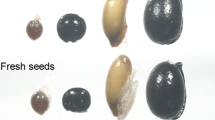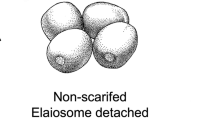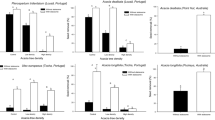Abstract
Erythronium dens-canis is a geophyte which produces a single flower each season. The fruits produce small seeds with relatively large elaiosomes. We performed experiments to investigate primary and secondary seed dispersal mechanisms of this species in different habitats in the western part of the Cantabrian Range in northwest Spain. Sticky traps were used to measure primary dispersal of seeds up to 0.5 m from mother plants. Seed cafeteria experiments were performed in different habitats to examine the role of ants and rodents in secondary seed transport and seed predation. Our results indicate that: (a) primary seed dispersal is positively skewed (99% of seeds fall within 20 cm of the mother plant) and seed dispersal distances vary significantly among plants; (b) secondary dispersal is exclusively by myrmecochory, although the proportion of seeds removed by ants differs significantly among habitats; (c) ant species composition and abundances vary among habitats; and (d) freshly dropped seeds are more likely to be removed than seeds that have begun to dry out. We conclude that secondary dispersal of seeds is greatly influenced by habitat but not by small-scale microhabitat.
Similar content being viewed by others
References
Beattie A.J. 1985. The Evolutionary Ecology of Ant-Plant Mutualism.Cambridge University Press, Cambridge.
Beattie A.J. and Culver D.C. 1982. Inhumation: how ants and other invertebrates help seeds. Nature 297: 627.
Berg R.Y. 1975. Myrmecochorous plants in Australia and their dispersal by ants. Australian Journal of Botany 23: 475–508.
Buide M.L., Sánchez J.M. and Guitián J. 1998. Ecological characteristics of the flora of the Northwest Iberian Peninsula. Plant Ecology 135: 1–8.
Culver D.C. and Beattie A.J. 1978. Myrmecochory in Viola: dynamics of seed-ant interactions in some West Virginia species.Journal of Ecology 66: 53–72.
Fenster C.B. 1991. Gene flow in Chamaecrista fasciculata (Leguminosae).I. Gene dispersal. Evolution 45: 398–409.
Gorb E.V. and Gorb S.N. 2000. Effects of seed aggregation on the removal rates of elaiosome-bearing Chelidonium majus and Viola odorata seeds carried by Formica polyctena ants. Ecological Research 15: 187–192.
Gorb S.N. and Gorb E.V. 1999. Effects of ant species composition on seed removal in deciduous forest in eastern Europe. Oikos 84: 110–118.
Gorb S.N., Gorb E.V. and Sindarovskaya Y. 1997. Interaction between the non-myrmecochorous herb Galium aparine and the ant Formica polyctena. Plant Ecology 131: 215–221.
Gorb S.N., Gorb E.V. and Punttila P. 2000. Effects of redispersal of seeds by ants on the vegetation pattern in a deciduous forest: A case study. Acta Oecologica 21: 293–301.
Guitián J. and Sánchez J.M. 1992. Seed dispersal spectra of plant communities in the Iberian Peninsula. Vegetatio 98: 157–164.
Guitián J., Guitián P., Medrano M. and Sánchez J.M. 1999. Variation in floral morphology and individual fecundity in Erythronium dens-canis (Liliaceae). Ecography 22: 708–714.
Handel S.N. and Beattie A.J. 1998. Semillas dispersadas por hormigas.In: Los Recursos de las Plantas. Investigación y Ciencia, Barcelona, pp. 36–43.
Heithaus E.R. 1986. Seed dispersal mutualism and the population density of Asarum canadense, an ant-dispersed plant. In: Estrada A. and Fleming T.H. (eds), Frugivores and Seed Dispersal.Dr W. Junk Publishers, Dordrecht, The Netherlands, pp. 199–210.
Herrera C.M. 2000. Flower-to-seedling consequences of different pollination regimes in an insect-pollinated shrub. Ecology 81: 15–29.
Horwitz C.C. and Schemske D.W. 1986. Seed dispersal of a neotropical myrmecochore: variation in removal rates and dispersal distance. Biotropica 18: 319–323.
Hughes L. and Westoby M. 1990. Removal rates of seeds adapted for dispersal by ants. Ecology 71: 138–148.
Jules E.S. 1996. Yellow jackets (Vespula vulgaris) as a second seed disperser for the myrmecochorous plant, Trillium ovatum.American Midland Naturalist 135: 367–369.
Kalisz S., Hanzawa F.M., Tonsor S.J., Thiede D.A. and Voigt S. 1999. Ant mediated seed dispersal alters pattern of relatedness in a population of Trillium grandiflorum. Ecology 80: 2620– 2634.
Kawano S., Hiratsuka A. and Hayashi K. 1982. Life history characteristics and survivorship of Erythronium japonicum. Oikos 38: 129–149.
Kjellsson G. 1985.Seed fate in a population of Carex pilulifera L.I. Seed dispersal and ant-seed mutualism. Oecologia 67: 416– 423.
Le Corff J.L. and Horvitz C.C. 1995. Dispersal of seeds from chasmogamous and cleistogamous flowers in an ant-dispersed neotropical herb. Oikos 73: 59–64.
Littell R.C., Milliken G.A., Stroup W.W. and Wolfinger R.D. 1996.Journal of Ecology 75: 1091–1098.
Ohkawara K., Higashi S. and Ohara M. 1996. Effects of ants, ground beetles and the seed-fall patterns on myrmecochory of Erythronium japonicum Decne. (Liliaceae). Oecologia 106: 500–506.
Oostermeijer J.G.B. 1989. Myrmecochory in Polygala vulgaris L., Luzula campestris (L.) DC. and Viola curtissi Forster in a Dutch dune area. Oecologia 78: 302–311.
Rice B. and Westoby M. 1986. Evidence against the hypothesis that ant-dispersed seeds reach nutrient-enriched microsites. Ecology 67: 1270–1274.
Richardson I.B.K. 1980. Erythronium L. In: Tutin T.G., Heywood V.H., Burges N.A., Valentine D.H., Walters S.M. and Webb D.A. (eds), Flora Europaea, 5. Cambridge University Press, Cambridge.
Ruhren S. and Dudash M.R. 1996. Consequences of the timing of seed release of Erythronium americanum (Liliaceae), a deciduous forest myrmecochore. American Journal of Botany 83: 633–640.
Smith B.H., Ronsheim M.L. and Swartz K.R. 1986. Reproductive ecology of Jeffersonia diphylla (Berberidaceae). American Journal of Botany 73: 1416–1426.
Smith B.H., Forman P.D. and Boyd A. 1989a. Spatial patterns of seed dispersal and predation of two myrmecochorous forest herbs. Ecology 70: 1649–1656.
Smith B.H., De Rivera C.E., Bridgman C.L. and Woida J.J. 1989b.Frequency-dependent seed dispersal by ants of two deciduous forest herbs. Ecology 70: 165–1648.
Turnbull C.L. and Culver D.C. 1983. The timing of seed dispersal in Viola nuttalli: attraction of dispersers and avoidance of predators.Oecologia 59: 360–365.
Van der Pijl L. 1982. Principles of Dispersal in Higher Plants. 3rd edn. Springer-Verlag, Berlin.
Weiblen G.D. and Thomson J.D. 1995. Seed dispersal in Erythronium grandiflorum (Liliaceae). Oecologia 102: 211–219.
Zar J.D. 1996. Biostatistical Analysis. 3rd edn. Prentice-Hall, New Jersey, USA.
Author information
Authors and Affiliations
Corresponding author
Rights and permissions
About this article
Cite this article
Guitián, P., Medrano, M. & Guitián, J. Seed dispersal in Erythronium dens-canis L. (Liliaceae): variation among habitats in a myrmecochorous plant. Plant Ecology 169, 171–177 (2002). https://doi.org/10.1023/A:1026043411357
Issue Date:
DOI: https://doi.org/10.1023/A:1026043411357




